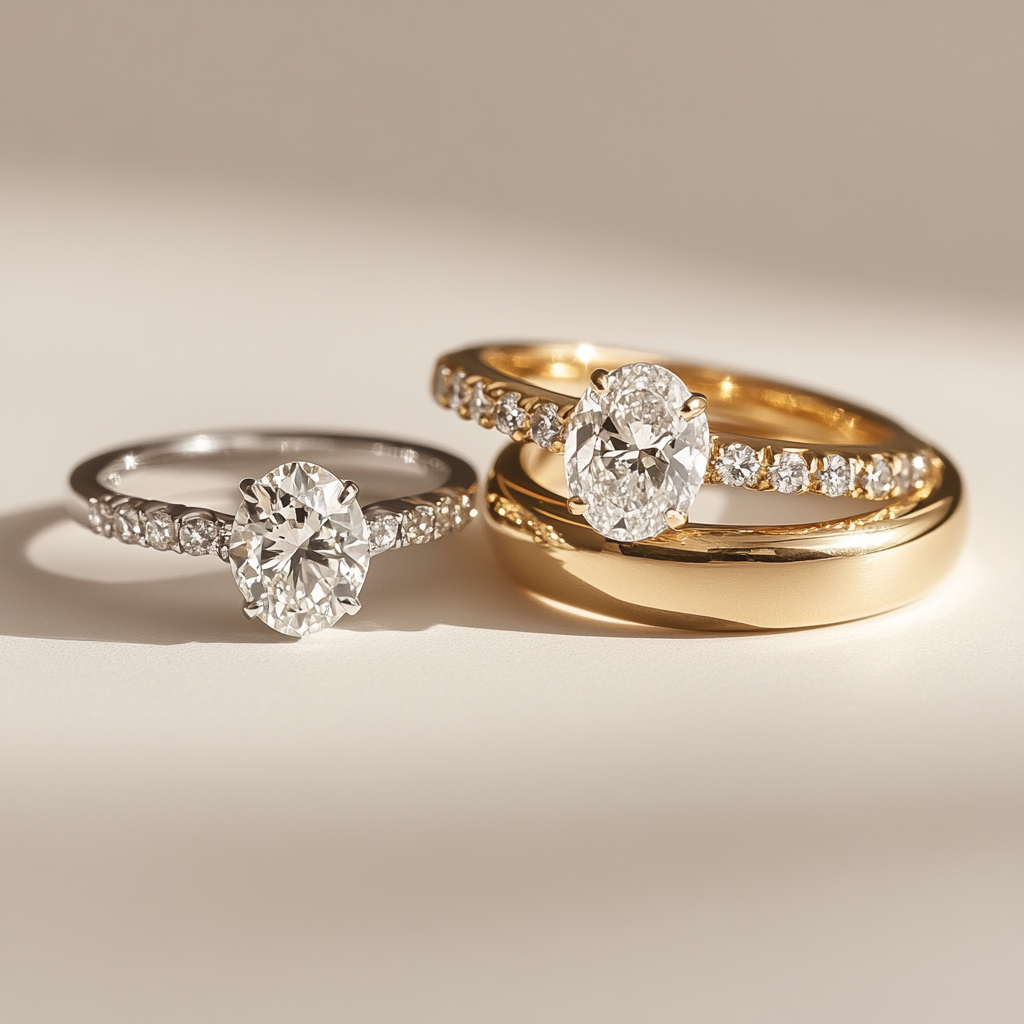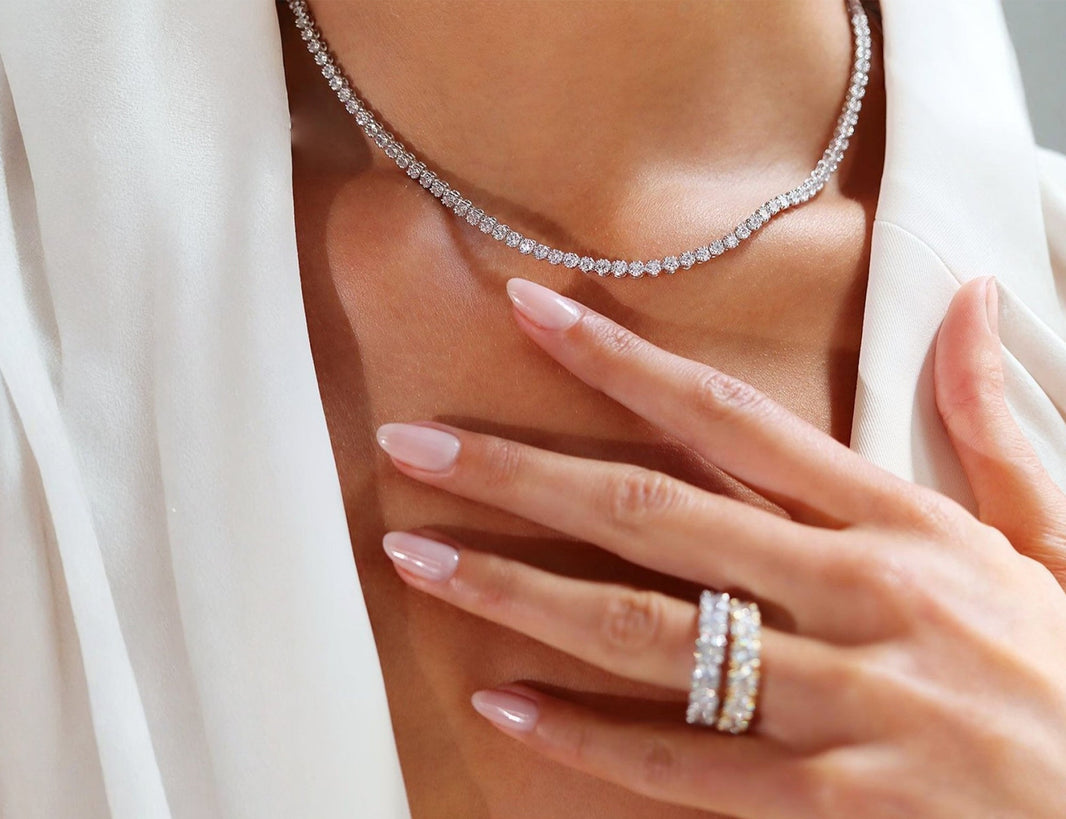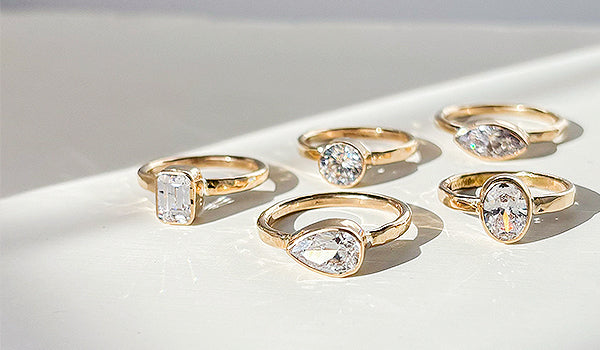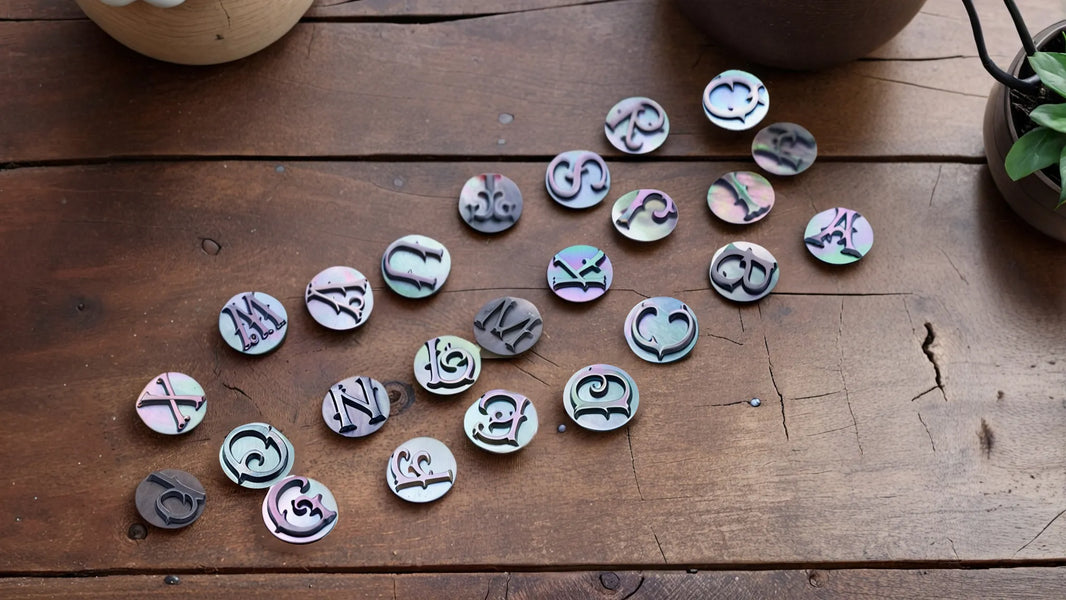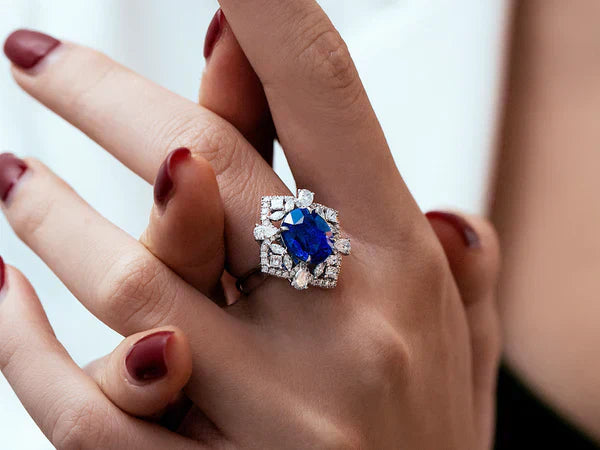Choosing the right carat size for your engagement ring can feel overwhelming, but it doesn’t have to be. Whether you’re eyeing a 1 carat lab grown diamond engagement ring or something a little smaller or larger, it’s all about what feels right for you and your partner. Carat size is just one part of the equation, and there’s more to it than simply picking the biggest stone. Let’s break down what really matters in choosing the perfect engagement ring carat size that suits your budget and her style.

What Does Carat Weight Actually Mean in Diamond Terms?
When you hear "carat," you might think it's about the diamond's size, but a carat is actually a unit of weight, not size. This distinction matters when shopping for lab-grown engagement rings.
A carat is precisely 200 milligrams – the approximate weight of a paperclip. This level of standardization provides consistency whether you are purchasing a natural or laboratory-created stone.
Here's the important part: two diamonds that have the same carat weight can appear totally different in terms of size. A 1 carat lab grown diamond engagement ring that is poorly cut may look smaller than a well-cut 0.9 carat stone because the weight is not distributed the same way. If a lot of the diamond's weight is in the bottom half, less of it will be showing from the top.
The carat scale is based on 100 points, so a 0.50 carat diamond is also referred to as a "50-point" diamond. You'll see price increases at important thresholds such as 0.50, 1.00, and 1.50 carats since these "magic numbers" have psychological importance to consumers.

Which Carat Size Will Make the Perfect Statement for Your Engagement Ring?
Every carat size tells a different story and fits different lifestyles, budgets, and personal preferences. When choosing between lab-grown engagement rings, understanding what each carat range offers helps you find the sweet spot that feels just right.
Carat Size Comparison Guide
| Carat Size | Best For | Ideal Hand Size | Lifestyle Match |
| 0.5 Carat | First-time buyers, active lifestyles | Small to medium hands | Very active, daily wear |
| 1 Carat | Traditional choice, balanced | Most hand sizes | Professional, versatile |
| 1.5 Carat | Luxury seekers, bold style | Medium to large hands | Statement-making, social |
| 2 Carat | Maximum impact desired | Larger hands preferred | Special occasions, glamorous |
| 2.5 Carat | A touch of luxury | Larger hands | High-end lifestyle, elegant |
| 3 Carat | Show-stopping beauty | Larger hands | Dramatic flair, bold statement |
| 4 Carat | Ultimate luxury, rare collector’s piece | Large hands | High-end, luxury lifestyle |
| 5 Carat | The ultimate showpiece | Large hands | Red carpet, luxury statement |
Size Breakdown:
- 0.5 Carat: A 0.5 carat diamond offers elegance and affordability. It’s ideal for small to medium hands and active lifestyles, providing a subtle, timeless look.
- 1 Carat: The 1 carat diamond is the most popular choice. It’s versatile, suits most hand sizes, and provides a classic, impactful look.
- 1.5 Carat: At 1.5 carats, the diamond feels more luxurious while still being understated. It’s a great choice for those wanting more size without going too big.
- 2 Carat: A 2 carat diamond makes a bold statement. It’s perfect for special occasions and glamorous styles, but works best on larger hands.
- 2.5 Carat: The 2.5 carat diamond offers luxury and extra sparkle. It’s ideal for those who want to stand out but prefer a refined size.
- 3 Carat: A 3 carat diamond offers a bold, luxurious look. It’s best for larger hands, making it perfect for those who want a showstopper.
- 4 Carat: A 4 carat diamond is extravagant and rare. It suits larger hands and is perfect for those who want a high-end, exclusive ring.
- 5 Carat: The 5 carat diamond is the ultimate statement piece. It requires large hands for balance and is ideal for those who want to make a lasting impression.
Each carat size offers a unique feel, so choose the one that matches your style, budget, and the statement you want to make.
Why Does Cut Matter More Than Carat Size for Your Diamond's Beauty?
While carat weight gets most of the attention when shopping for lab-craeted engagement rings, cut quality is what actually makes your diamond sparkle like crazy. A perfectly cut smaller diamond will always outshine a poorly cut larger stone. Understanding cut quality helps you get the most bang for your buck, no matter what engagement ring carat size you choose.
It's All About the Sparkle
Think of cut as your diamond's personality. When a diamond is cut just right, light bounces around inside and shoots back out as those gorgeous flashes that make people go "wow." If the cut is off, light just leaks out the sides and bottom, leaving you with a dull stone that looks more like glass than a diamond.
The Grading System Makes It Simple
Diamond cuts are graded from Excellent down to Poor, and honestly, you want to stick with Excellent or Very Good. When you're looking at a 1 carat lab grown diamond engagement ring, choosing an Excellent cut over a slightly bigger stone with just a Good cut will give you way more sparkle and visual pop.
Better Cut Means It Looks Bigger
Here's a cool trick: a well-cut diamond actually looks larger than its carat weight suggests. The cut determines how much of the diamond's surface you can see from the top, which is what everyone notices when they're admiring your ring. So good cut quality basically gives you more diamond for your money.
Different Cuts, Different Vibes
Round diamonds are the sparkle champions with their 58 facets designed for maximum bling. Princess cuts give you bright flashes with a modern square look. Emerald cuts are more about elegant, mirror-like reflections. Each style creates its own kind of beauty, so think about what matches your partner's style. Many couples are discovering new favorite lab diamond cuts that work beautifully for anniversaries and holiday proposals.

It's Worth Spending More on Cut
Yes, better cut grades cost more upfront, but they're totally worth it. A diamond with excellent cut will keep looking amazing every single day, while a poorly cut stone might leave you feeling "meh" about your ring. Think of it as insurance for long-term happiness with your choice.
How to Make Your Diamond Look Bigger and Brighter Without Breaking the Bank
Smart shopping isn't about finding the biggest stone – it's about maximizing the visual impact of whatever size you choose. Whether you're eyeing a 1 carat lab grown diamond engagement ring or working with a smaller budget, these insider tricks will help you get more sparkle and presence for your money.
Choose the Right Shape for Maximum Impact
Round diamonds might be classic, but they're not always the best bang for your buck. Oval, marquise, and pear shapes actually look bigger than round diamonds of the same carat weight because they spread the weight across a larger surface area. An oval 0.75-carat stone can look as big as a 1-carat round, saving you serious cash while delivering that "wow" factor.
Master the Art of Strategic Compromise
Here's the secret jewelers don't always share: you can drop down in color and clarity without anyone noticing, but never compromise on cut. Go for H or I color instead of D-F, and choose VS2 or SI1 clarity instead of flawless. Put those savings toward a larger stone or better cut quality – trust us, the visual difference is night and day.
Pick Settings That Amplify Your Stone
A halo setting surrounds your center diamond with smaller stones, making it look significantly larger. Thin bands make the center stone appear bigger by comparison. White metal settings like platinum or white gold make diamonds look brighter and larger than yellow gold. These setting tricks can make a 0.8-carat stone look like a full carat.
Shop Just Below Popular Carat Weights
Here's a money-saving tip: purchase a 0.9-carat rather than 1-carat, or 1.8-carat rather than 2-carat. These tiny variations are undetectable to the naked eye yet can save you 10-20% on cost. Most individuals can't differentiate between these measurements, yet your wallet certainly will.
Focus on Table Size and Depth
Seek diamonds with table percentages of 54-60% and depth percentages of 59-62%. These ratios optimize the diamond's face-up appearance, allowing it to appear larger and more brilliant. A 0.75-carat stone with good proportions will always dazzle more than a 1-carat with poor proportions.
Consider Lab-Grown for More Size
Lab-created engagement rings are equal to natural diamonds in beauty and durability but cost 30-50% less. You can thus save money or get a bigger stone for the same price. For example, a 1.5-carat lab-created diamond could be priced the same as a 1-carat natural diamond.
Time Your Purchase Right
Diamond prices vary during the year. Steer clear of the high engagement seasons (November to February) when prices are at their peak. Purchase during off-season months such as March, April, or July for lower prices. Black Friday and year-end sales can also provide huge discounts on engagement ring carat weights.
Get the Certificate But Don't Obsess
Always purchase certified diamonds (GIA or equivalent), but don't obsess over flawless grades. A "Very Good" cut, H color, and VS2 clarity diamond will shine beautifully to all except gemologists with magnifying glasses. Reserve the premium grades for bragging rights, not for visual effects.
How to Choose a Ring That Matches Her Daily Life and Personal Style
The ideal engagement ring is not only a matter of getting the right carat size – it's a matter of selecting something she'll enjoy wearing every day for the rest of her life. Whether you're looking at lab-grown engagement rings or conventional ones, knowing her lifestyle and personal style will lead you to a ring that feels distinctly hers.
Match Carat Size to Her Job and Daily Activities
Different lifestyles call for different carat sizes and settings. An active professional needs a practical ring that won't interfere with work, while someone in a corporate environment might prefer something with more presence. Here's how to match carat size to her daily routine:
| Lifestyle Type | Recommended Carat Range | Best Setting Style | Why This Works |
| Active Professional (doctor, athlete, hands-on work) | 0.5 - 1.0 carat | Low-profile, bezel or flush setting | Won't catch on gloves or equipment; secure stone placement |
| Office Professional (desk job, meetings) | 0.75 - 1.5 carat | Classic solitaire or halo | Professional appearance; comfortable for daily wear |
| Creative/Artistic | 0.5 - 1.25 carat | Unique settings, vintage styles | Allows for distinctive design; matches creative personality |
| Social/Outgoing | 1.0 - 2.0+ carat | Statement settings, halos | Creates conversation pieces; matches bold personality |
| Minimalist/Understated | 0.5 - 0.75 carat | Simple solitaire, thin band | Clean lines; won't feel overwhelming |
Choose the Right Size for Her Hands
Hand size and finger length play a huge role in how different carat sizes look and feel. A 1-carat stone might look perfect on longer fingers but overwhelming on petite hands. Use this guide to find the most flattering carat range:
| Hand Size | Finger Length | Ideal Carat Range | Best Diamond Shape | Band Width |
| Petite Hands | Short fingers | 0.5 - 1.0 carat | Oval, marquise, pear | 1.5-2.5mm |
| Petite Hands | Long fingers | 0.75 - 1.25 carat | Round, emerald, oval | 2-3mm |
| Average Hands | Short fingers | 0.75 - 1.5 carat | Oval, marquise, cushion | 2-3mm |
| Average Hands | Long fingers | 1.0 - 2.0 carat | Any shape works well | 2.5-4mm |
| Larger Hands | Any length | 1.25 - 2.5+ carat | Bold shapes, emerald cut | 3-5mm |
Pick a Carat Size That Fits Her Personality
Her personal style should guide your carat choice just as much as practical considerations. Someone who loves classic elegance wants something different than someone who follows every fashion trend. Here's how personality affects the ideal engagement ring carat size:
Classic & Traditional Style
- Prefers timeless pieces that won't go out of style
- Ideal range: 0.75 - 1.5 carat
- Best choice: 1 carat lab grown diamond engagement ring in round or princess cut
- Setting: Solitaire or simple halo
Modern & Minimalist Style
- Loves clean lines and understated elegance
- Ideal range: 0.5 - 1.0 carat
- Best choice: High-quality cut in smaller size
- Setting: Thin band solitaire or bezel setting
Glamorous & Bold Style
- Enjoys making statements with jewelry
- Ideal range: 1.25 - 2.5+ carat
- Best choice: Larger stones with maximum sparkle
- Setting: Halo, three-stone, or vintage-inspired
Bohemian & Artistic Style
- Values uniqueness over size
- Ideal range: 0.5 - 1.25 carat
- Best choice: Unique cuts or colored accents
- Setting: Vintage, nature-inspired, or custom designs
Consider How Much Ring Care She Wants
Some people love maintaining their jewelry, while others want something totally hassle-free. Your carat choice should match her maintenance preferences because larger stones and certain settings require more upkeep:
Low Maintenance Preference
- Choose: Bezel or flush settings
- Avoid: High prongs, delicate settings
- Carat focus: Quality over size for durability
High Maintenance Acceptable
- Choose: Prong settings for maximum sparkle
- Consider: Larger stones that require more care
- Carat focus: Can prioritize size and brilliance
The ideal carat size of an engagement ring gives fair weight to her present desires and practical considerations for the decades to come.
Finding Your Perfect Engagement Ring Carat Size
Whether you opt for a dainty 0.5-carat stone or splurge on a 1 carat lab grown diamond engagement ring, the ideal choice is one that fits her style and your budget. Lab-created engagement rings provide you with incredible value, so you can invest in what truly counts: excellent cut quality and a ring she'll enjoy wearing every day. Go with your gut, don't rush, and keep in mind that the ideal ring is the one you select together..



